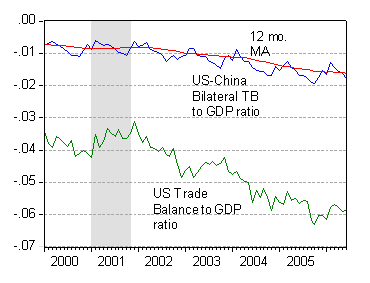The Renminbi (RMB) is probably undervalued, according to some criteria. Would adjusting it fix the US-China trade deficit? Or the overall US trade deficit?
China looms large in the world economy. There is lots of talk about Treasury Secretary Paulson pushing more deftly to achieve greater RMB appreciation. In my view, if he’s successful, this would be a good outcome for the U.S. and world economy.
While I discussed this issue recently, I thought a closer look at the data was warranted after the trade release for June came out. The figure below confirms that the annualized bilateral trade deficit with China has widened in recent months, even as the Chinese RMB has appreciated in real terms (down is a RMB appreciation against the USD in real terms).

Figure 1: Real CNY/USD exchange rate (blue) against US-China bilateral trade balance in billions $, nsa (red), and 12 month moving average (green). Source: IMF International Financial Statistics and BEA/Census June trade release.
But I have a caveat. I find it of interest that the 12 month moving average of the bilateral trade balance (green line) has slowed its descent (I have been trying to seasonally adjust the Chinese trade series, without much success, but that problem is left for another day).
However, as macroeconomists we know we shouldn’t really care about the bilateral trade balance. In the next graph (Figure 2), I’ve shown the US-China and aggregate US trade balances, expressed as a share of nominal US GDP (blue and green lines respectively).

Figure 2: US-China bilateral trade balance (nsa) to nominal GDP ratio (blue), 12 month moving average (red), and US trade balance (sa) to GDP ratio. Source: BEA/Census June trade release, St. Louis FRED for nominal GDP, interpolated, and author’s calculations.
As Figure 2 indicates, China is only part of a much bigger problem in terms of our trade imbalance. Furthermore, as has been pointed out in other contexts, imports from China have been substituting for imports from other economies, East Asian and other. This in turn is related to question of exactly how much value-added is in Chinese exports to the United States.
Nothing new in these observations, but they are points that should be kept in mind as the rhetoric heats up over RMB appreciation. RMB appreciation will be welcome — particularly as it implies fewer acquisitions of US dollar assets by the People’s Bank of China — but it is not a substitute for fiscal adjustment on the structural budget balance; responsible action by US policymakers is a prerequisite for meaningful global rebalancing [pdf].
For other discussion of the RMB issue, see Brad Setser, who discusses the World Bank’s recent report on China; David Altig at Macroblog on debate over how much appreciation; Calculated Risk observes that the growth rate of US imports from China has been falling.
Technorati Tags: trade deficits, global rebalancing, real exchange rate, China,
Renminbi, and RMB
Maybe we should consider CNY appreciation from China’s position. CNY appreciation is good for China’s development .
Maybe we should consider fixing the massive US imbalances from the US position. Fixing the budget deficit, household savings deficit and political leadership morality deficit would be good for America’s development.
As an unintended consequence, the trade deficit would improve as well.
.
What does the graph tell us about the dollar? Is it over or under valued? Is the dollar the center of the universe? Is the earth?
Dick: Please see Figure 2 of the post I mentioned. There you can see a graph of the trade weighted effective exchange rate of the CNY (CPI-deflated). For a trade weighted effective exchange real value of the dollar, see Figure 4 of this post.
I would claim the opposite. From a chinese point of view, the RMB exchange rate may be at its equilibrium given the amount of unemployed in China (100-150 millions), moreover PPP, BEER, and FEER models are not accurate for developing countries, as it can be seen in a working paper i wrote with two colleagues.
“The RMB equilibrium exchange rate: an agnostic view”
http://www.ofce.sciences-po.fr/pdf/dtravail/WP2006-13.pdf